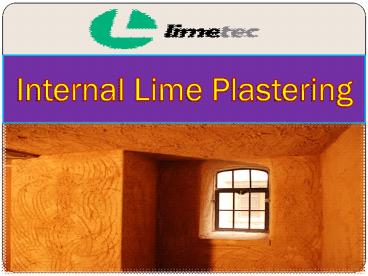Internal Lime Plastering PowerPoint PPT Presentation
Title: Internal Lime Plastering
1
Internal Lime Plastering
2
The promotion of modern gypsum-based plasters has
led to the almost complete demise of lime
plastering, and of many of the traditional skills
associated with the craft. This has been
exacerbated by the plastering trade being divided
into flat and decorative work, with new 'fibrous
plasterwork' being made in workshops. Many
youngsters entering the trade are now just taught
the basic skills to enable them to stick up
plasterboard and skim plaster onto it. We are
told that it is all down to 'supply and demand'
if this is the case, those of us involved in work
on old buildings need to be more demanding.
3
(No Transcript)
4
(No Transcript)
5
There is a real need for skilled plasterers who
can plaster with lime, and also turn their hands
to repairing and reinstating dado and cornice
mouldings in situ. The current training system
works against anyone gaining this set of skills.
6
(No Transcript)
7
An article like this cannot resolve this skills
shortage, nor attempt to even describe the range
of skills that a traditional plasterer should
have. There are, however, some general principles
which anyone involved with lime plastering should
be aware of. Sadly there are too many cases of
lime plasters failing because the people who have
specified the work or the people carrying out the
work don't have adequate knowledge or experience.
8
(No Transcript)
9
(No Transcript)
10
THE RIGHT MATERIALS?
Most people using lime in old buildings have a
vague understanding of the benefits of a
'breathing' mortar or plaster, but if they
perceive that lime is too difficult to use they
may decide not to bother with it. We need to make
it clear that the revival of the use of lime is
not some 'airy fairy' idea dreamt up by a bunch
of idealists. On the contrary, it is driven by
the realisation that buildings are suffering
because they have been coated with inappropriate
materials, and the people living in them may be
less healthy as a result. There is compelling
evidence that modern gypsum plasters encourage
condensation and consequent mould growth if used
on walls that are supposed to 'breathe'. We are
beginning to see a revival in the use of lime
plasters and we need to encourage a revival of
the skills required to use them
11
(No Transcript)
12
(No Transcript)
13
Having bemoaned the lack of proper training for
anyone wanting to learn traditional plastering
skills, it has to be said that lime plastering is
not rocket science. With a basic understanding
and a willingness to learn, most plasterers can
pick up the skills required to produce a
reasonable job in a few days. This is not the
same as the skill required to repair plaster in a
fine quality country house, or the experience
required to match a range of historic finishes,
but these things come with time, and we can hope
that as more plasterers learn to use lime they
will be inspired to develop their skills and
understanding further.
14
(No Transcript)
15
There are two characteristics that differentiate
lime plasters from modern plastering materials.
The first is that they set slowly by absorbing
carbon dioxide from the air, in the presence of
moisture. The second is that they will shrink as
they dry.
16
(No Transcript)
17
Although hydraulic limes, which set more quickly
than white/fat limes, are occasionally used for
plastering in damp conditions, they are less
flexible and breathable than the latter, and
their use internally should generally be avoided.
All the evidence on old buildings and in written
documentation indicates that for centuries, if
not millennia, plasterers have chosen to use
white/fat limes for internal plastering.
18
(No Transcript)
19
There is some debate about whether we really need
to use traditionally slaked lime putty, or if
bags of dry hydrated white lime from the
builders' merchant are just as good. Although
chemically they are the same (both are calcium
hydroxide), a traditionally slaked lime, which
has been matured for three months, will have
broken down into much smaller particles and
started to form crystal chains. This gives it
better adhesive qualities, helping it to grip the
wall more tenaciously. The difference seems to be
in the maturing process so if recently hydrated
lime from a fresh bag is left to soak in water
for three months, it should be as good as a
traditionally slaked and matured lime. However,
in practice most of us find it is easier to buy
the matured stuff from a specialist supplier.
20
(No Transcript)
21
For more update , visit us
Phone 44 1235 434300
Email info_at_limetec.co.uk
Address Limetec LMR Traditional
126 Olympic Avenue
Milton Park
Abingdon OX14 4SA
United Kingdom
Website https//limetec.co.uk
22
(No Transcript)

